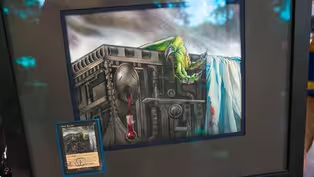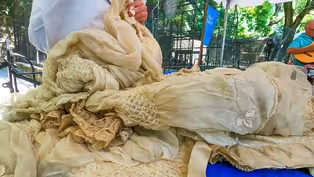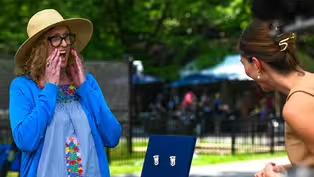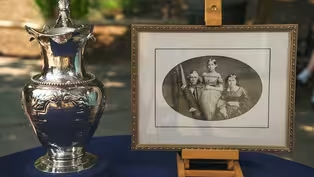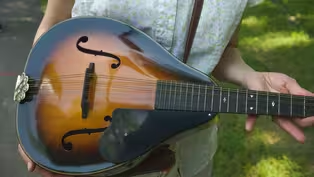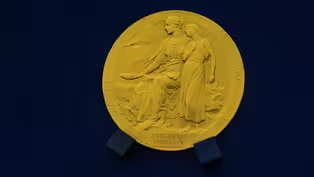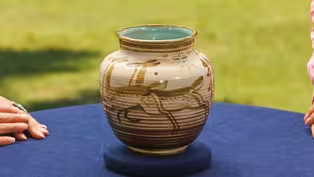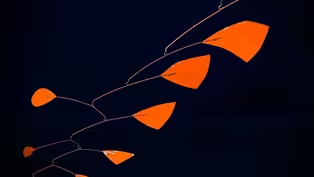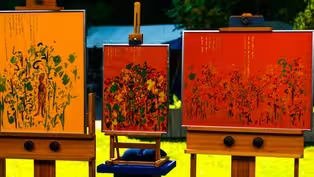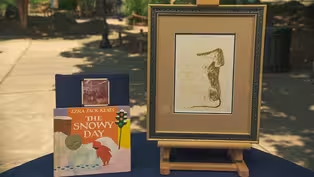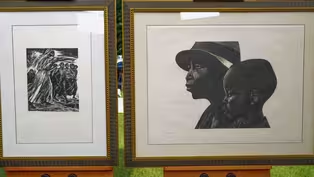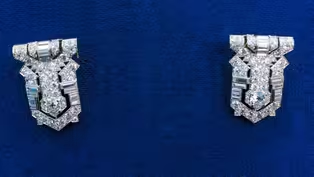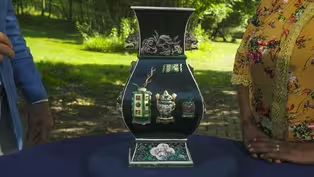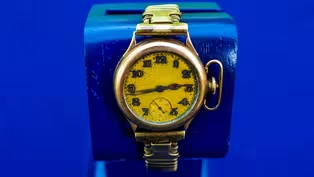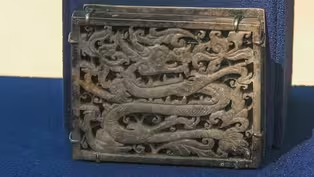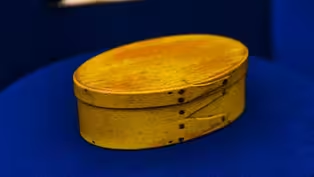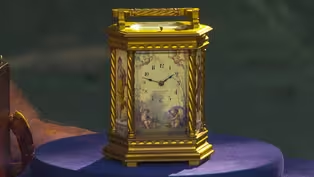
Maryland Zoo, Hour 3
Season 29 Episode 15 | 52m 27sVideo has Closed Captions
ROADSHOW searches for hidden treasures in Maryland including one $150,000 - $200,000 find!
ROADSHOW visits Maryland and finds George Patton's WWI trench watch, a 1949 Charles Loloma pot and Joseph Erlanger's Nobel Prize & diploma.
Problems playing video? | Closed Captioning Feedback
Problems playing video? | Closed Captioning Feedback
Funding for ANTIQUES ROADSHOW is provided by Ancestry and American Cruise Lines. Additional funding is provided by public television viewers.

Maryland Zoo, Hour 3
Season 29 Episode 15 | 52m 27sVideo has Closed Captions
ROADSHOW visits Maryland and finds George Patton's WWI trench watch, a 1949 Charles Loloma pot and Joseph Erlanger's Nobel Prize & diploma.
Problems playing video? | Closed Captioning Feedback
How to Watch Antiques Roadshow
Antiques Roadshow is available to stream on pbs.org and the free PBS App, available on iPhone, Apple TV, Android TV, Android smartphones, Amazon Fire TV, Amazon Fire Tablet, Roku, Samsung Smart TV, and Vizio.
Buy Now
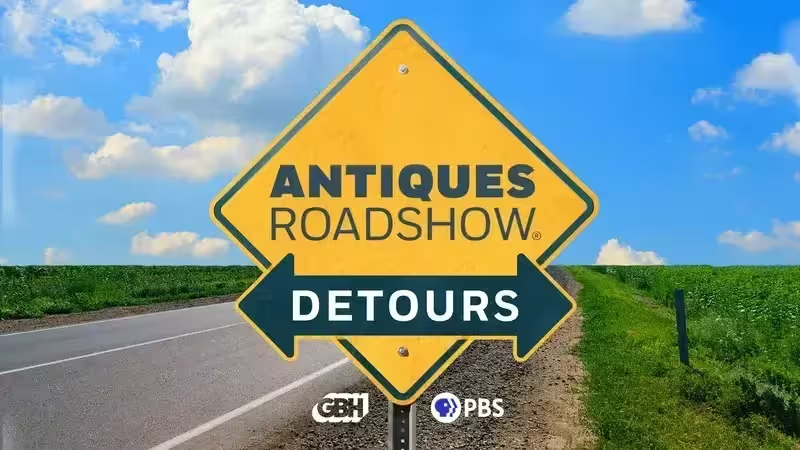
ANTIQUES ROADSHOW DETOURS
Ever wondered what happens to the treasures featured on America’s beloved ANTIQUES ROADSHOW after the cameras leave town? Host Adam Monahan tracks down the juicy afterlives of your favorite finds from PBS’s hit series.Providing Support for PBS.org
Learn Moreabout PBS online sponsorship♪ ♪ CORAL PEÑA: "Roadshow's" own travelling zoo has come to the Maryland Zoo in Baltimore.
He was a creative master, and this is one of the best pots I have ever seen.
Oh, my goodness.
I never would expect that, no-- I'm in shock.
♪ ♪ PEÑA: The Maryland Zoo is a wild location for our "Roadshow" event today.
In addition to providing wildlife education, the Maryland Zoo is deeply committed to animal conservation.
One creature that is part of the Maryland Zoo's conservation efforts, the Panamanian golden frog, whose bright yellow color is a warning to predators that it is toxic.
Ironically, in Panamanian culture, the frog is also said to bring good luck.
What luck have our experts had in finding treasures today?
Take a look.
♪ ♪ This is a piece that I bought in downtown Baltimore over 40 years ago from a local artist.
This is probably the second time it's been out of my home.
It's my treasure.
"Roadshow" is coming to town, so I said I'll bring it over here and let people take a look at it-- it's awesome.
I inherited this from my stepfather.
So, I know it's a Gibson-- it is "the" Gibson.
It's from 1925, I think.
It's a four-string banjo.
Don't play banjo yet, uh, just learning now.
GUEST: I brought a pair of Cartier diamond and platinum dress clips that belonged to my mother.
My mother got them from my father, who bought them from a family friend and jeweler out in New London, probably in the early '70s.
She loved them, and she wore them every Saturday night.
She was six-feet-tall.
Oh, wow.
(chuckles) Dark hair, dark eyes, red lips, red fingernails, and she was always dressed in black.
Oh... And so, she wore them one on each side... Beautiful.
...of her dinner jacket.
So, they, to me, mean good times.
They're really special, and when she died, about ten years ago, my father gave them to me.
When he was a little boy, he went to work really early, and, um... Wow.
one of the places he worked was a jewelry store in New London called Mallove's.
Wow.
Harvey Mallove was the owner, and he took my father under his wing.
And when my dad was married, Harvey would call my father whenever he got something good, and he got a bunch of jewelry that was deaccessioned from a museum in New London, and these clips were part of that lot that my father bought.
Harvey must've really loved your dad.
(laughs) He did.
(laughs) Yeah, you know, in a special way because these are incredible clips.
They are platinum, diamond Cartier clips.
They could've been worn as your mother wore them, on, on a lapel, clipped onto a bag.
What's great about jewelry from this period-- and I would date these to around about 1930.
Okay.
So sort of mid-Art Deco period-- is that they were multipurpose.
Cartier was the first to really manipulate platinum.
At the end of the 19th century, they really turned platinum into a precious metal and something that was used in jewelry, which it previously had not been.
These are signed Cartier.
Uh, they also have a serial number.
Mm.
And they're signed on both clips.
Yeah, I see.
Originally, they would've been together on an armature so you could wear them like a double-clip brooch, like this.
Oh, wow.
Yeah.
Cartier was founded in 1847 by Louis-François Cartier, and it would really be his grandsons, Pierre, Jacques, and Louis who would make the brand worldwide.
Altogether, you have about 20 carats of diamonds.
(gasps) The two large center stones are each about two carats.
Oh, wow.
Uh, there's baguette-cut diamonds that flank them on either side, and then a mix of old European-cut and old mine-cut diamonds... Mm.
...throughout the rest of the clips.
Mm-hmm.
They are the height of quality.
They're incredibly luscious, and sparkly, and well-matched.
Do you know what your father purchased them for?
I know that he paid $7,000 for the lot.
Okay.
I don't know what was in the lot, and he doesn't remember either.
Okay.
Conservatively, I would say an auction estimate on the pair would be in the neighborhood of $30,000 to $50,000.
Wow.
Wow.
They truly are museum pieces.
That surprises me.
(chuckles) I never-- you know, when you love something, you don't really ascribe a value to it.
Yeah.
So, it's a bonus.
I'm just happy to see them out.
Yeah.
(laughs) Out in the daylight, sparkling.
And my father will be so thrilled.
Oh, I'm so happy.
They meant a lot to him and a lot to my mom.
Well, they're beautiful, he had incredible taste, and...
Thank you, Katherine.
It's the best of the best.
I'm gonna cry!
(both laughing) (laughing): It's really hard-- Don't cry, I'll cry!
(laughing) It's really hard to believe-- you have no idea how special these were.
GUEST: I brought in three paintings, watercolors, by Faith Ringgold.
I... (chuckles) was working in a nursing home in New York City, and they were having a flea market.
I had been looking for a red painting.
The one closest to you was leaning against the table leg at the flea market.
Okay.
And I said, "Got to have it."
On the other end of the table was the smaller red painting.
Ah.
And I said, "I'll take that one, too."
You hit the red painting jackpot.
(laughs): I did!
As I was standing at the table, another colleague came and said, "I have a third painting "by the same artist in my office, but the only thing "is that the glass is broken.
Do you want it?"
And I said, "Sure."
For the one closest to you, I paid five dollars.
And the one in the center, I paid two dollars, and of course, this one, because it was just brought to me, I paid nothing for it.
All three are in the original frame.
Okay.
How long ago was it that you bought these?
I bought these in about the late 1990s, 1997.
I was wondering if you wouldn't mind reading, just pick one of these paintings...
Okay.
...and read the poem for us.
Okay, sure.
This one closest to me, says, "From your evening colored woman, "I am blood red, evergreen, midnight blue, black in love with you, man."
These are all watercolor paintings...
Yes.
...by Faith Ringgold, born in 1930, and she died just this year, which is 2024.
Yeah.
In April of this year.
Two months ago, yeah.
She was 93 years old at the time of her death.
Yes, yes.
And she's mostly known for her textile works, but she did quite a big body of work on paper, too.
And she actually dated them.
This one is May 1973 and puts "NYC," New York City.
Yes.
The same thing here.
Correct, yes.
May 1973, New York City.
And the same here-- here is her painting by Faith Ringgold, and it says, "Words by Michele Wallace."
Her daughter.
It says the same thing on all three.
Yes.
And then, at the same time, it's also signed in pencil down here.
Yes.
It's titled "Love Poem 1," and then it says, "New York City, May 1973."
Faith Ringgold."
Mm-hmm.
Mm-hmm.
They both have the title, "Love Poem 2 No.
3."
This says, "Love Poem 2," uh, number three.
But also, notice that the poem is exactly the same.
Yes.
This series is part of the Political Landscape Love Poem series.
Yeah.
All three together... Mm-hmm.
...would be worth $70,000-- insurance.
Oh, my.
So, if I were to a-- I would tell you to insure these.
I would tell you to insure them for $70,000.
Oh, my.
Oh, my.
It's a huge... (laughs) ...difference from what you paid, seven dollars to $70,000.
Yeah, oh, my goodness.
And congratulations, what a find.
Thank you!
I can't believe it.
I never would expect that.
No-- I'm in shock.
(both laughing) I'm in shock!
Excellent.
I figured, maybe, every, you know, $3,000 to $5,000, but, no.
Oh no, these are totally awesome.
So, I have a Sensenich airplane propeller from the 1940s.
This was actually something I won at a white elephant game at the College Park Aviation Museum.
I was definitely, uh, smaller than the propeller when I won it, and I was about the happiest kid you can imagine.
I believe it's actually flown.
Although, it's, uh, it's no longer quite in shape to fly anymore.
One of my favorite collectibles and, um, just wanted to see, to learn more about it.
We got them from an antique mall about 15 years ago, and the guy didn't know what they were, and... it's a, it's a part of a whole set, but I figured I'd bring these in so I don't have to bring in the bed and the dresser and everything.
Think it was $500 for the whole set.
GUEST: So, I brought a clip that my mother had for many years.
It sat in my office for at least... 23, 24 years.
She was a collector of all different things.
We grew up in the Upper West Side.
She happened to take care of a lot of folks in our building.
They gifted her things, 'cause she was a lovely woman.
She gave it to me.
Asian pieces are a highlight for me when we're watching the show.
I think it's a paperclip to hold actual paper.
What we have here is a gray jade dragon plaque dated to the Ming period, which is 1368 to 1644.
In the center of the plaque, we have a dragon.
The eastern dragon, unlike its western counterparts, does not have wings.
It flies through the air, kind of snake-like, sinuous form.
It has scales, long nose, whiskers and horns.
It is flying through, uh, some foliage.
You have some beautiful blossoming flowers in, in the corners, and the little curling stems could be clouds or a part of the, the field that he's flying through.
This plaque would've been one of several that would have been sewn onto a leather belt.
This plaque would most likely be in the center, j-just judging on its size, and then, you would have other jade, similarly-carved plaques around, and you would've worn it around your waist as a belt.
This belt would've been worn by somebody of privilege and rank because the material itself is quite rare and is a luxury material.
The jade plaque is mounted on this silver clip.
Opens up in the back.
The silver clip is probably from the early 20th century, 1920s.
But it's really the jade itself that is the, the value here.
This gray jade dragon plaque at auction would be estimated around $3,000 to $5,000.
Oh, my God.
Wow!
(laughing): You're kidding me.
That's awesome.
So exciting.
(chuckles) I can't believe I'm here.
KATELYNN NEWELL: Okapi are actually often confused with being related to zebra, but they are actually in the same family as giraffe.
Giraffe are their closest living relative.
They're in the Giraffidae family.
They're kind of affectionately called the forest giraffe.
Their head shape is very similar and even their gait.
They move both legs on each side at a time.
It's called an amble.
Another thing that's similar is their tongue.
They both have about 18, 20-inch tongue.
A lot of people don't see those similarities because okapi are so much smaller.
Okapi are found in the Democratic Republic of the Congo, which is a really densely forested area in Africa.
GUEST: This is descended directly down through the family.
This pitcher was an award to William Cannon, who was the governor of Delaware during the Civil War, and it was presented to him in December of 1864.
And, unfortunately, he died in the beginning of March of 1865, so he did not see the end of the war.
The picture here is of the governor and his wife before he became governor, uh, with their eldest daughter Elizabeth.
Mm-hmm, so who gave it to him?
It was given to him by the ladies of the Sanitary Commission.
We don't know exactly what he did to achieve this... Mm-hmm.
...'cause he was a Republican governor in a Democratic state who won by a very small margin, and they would not pass anything he wanted to do.
So, we don't know exactly why he or how he achieved this great honor.
This pitcher was presented in 1864.
The U.S. Sanitary Commission was founded in 1861 to support and tend to the Union soldiers during the Civil War.
Women all over the country would be organized to raise money for it.
Okay.
And so, the ladies in Delaware were raising money, and I think probably because he was an official in the state, he would be the natural person to receive this.
It was really a way that women stepped forward.
Yes.
I mean, I, I liken it to, they woke up every day and thought, like, "How can I make the world a better place?"
Right.
So, you had Louisa May Alcott involved in it, writer of "Little Women."
Yeah.
Um, Dorothea Dix and, uh, Clara Barton, started the Red Cross.
Yes.
And, on top of it, you've got this spectacular sterling silver pitcher.
Yes.
Which, uh, we, we know by the marks on the base, uh, were made by, uh, the Bailey & Company, and there's a little, uh, sort of "S" at the bottom, which stands for "George Sharp."
He was an Irish silversmith and worked for the Bailey Company.
Whatever George Sharp made it was the finest of, of their work.
It's a, a water pitcher.
So, this is really a spectacular piece, and the more we go around with it, the more we see its repoussé work, the Renaissance Revival details, which you'd see on buildings in the Renaissance, spectacular scroll, which looks to me like an exotic bird here at the top.
Mm-hmm.
It's really a tour de force of design work.
And then wonderfully inscribed, "From the ladies, uh, to, to the governor."
To insure it, I would probably place it in the $10,000 to $15,000 range.
Oh, no!
Yeah, yeah.
No, it's... Oh, my God.
It's, it's lovely.
It's really lovely.
Oh, wow.
(soft chuckle) This is probably its first public outing since 1864.
It's a one-off irreplaceable.
GUEST: This is a wristwatch that was given to my grandfather, George S. Patton Jr., by my grandmother, his wife, Beatrice Ayer Patton, after World War I.
It was given to me by her in 1952.
It's been in a shoebox in the top of a closet almost forgotten about.
It's definitely from the World War I period.
It's a trench watch.
This one here is made by Waltham.
That's an American watch company out of Waltham, Massachusetts.
Started in the 1850s.
I've seen hundreds upon hundreds of World War I military trench watches.
I don't remember seeing... (soft chuckle) ...another solid gold one, ever.
Wow.
You can see this little guard...
Yes.
...over here, that protected the crown.
Okay.
So, in action, the crown wouldn't break off.
You are missing the crystal, the glass.
Yes.
Not a big deal.
Uh, the dial is original, and you can see all the radium there, that's all faded.
Let's take a look at the back of the watch.
There's a hand-engraved presentation that was from your grandmother, and it reads, "Lieutenant colonel George S. Patton Jr.
Tank Corps," and below that is the word "mizpah," which is a Hebrew word that has several meanings.
I think the meaning here was that God is watching over you while we're apart.
One of a kind, I would think, wouldn't you?
I would think so, too.
Your grandfather, George S. Patton, American hero.
There's a name that's known all over the world.
Even though this is World War I, and not World War II, where he garnered all that fame and all that notoriety, it's still an important piece of American history, so you have all these American history buffs; you have watch people, you have military people.
Everybody's gonna hunt this watch down.
In today's auction market, this watch will bring $100,000-plus.
Wow.
Amazing.
The coverage for insurance value should be just a little higher.
Okay.
So, maybe $115,000 to $135,000 for insurance values.
Okay.
(chuckling): Maybe I better change some of the coverage.
You think you'd better up it a little bit?
Yes.
And it doesn't even work.
(laughs) No, it's broken.
Yeah.
GUEST: My grandfather was a salesman for a construction equipment company.
Mm-hmm.
And this is what he used to take around to show people how this piece of equipment worked.
Obviously, it's a, a digger of some sort.
I love salesman samples, and my favorite is when I find a salesman sample that was owned by a salesman for sure and we know it.
Yup.
The beauty of salesman samples is they threw everything at 'em.
Right.
They spared no expense to make something, and this was really quite a piece.
It's heavy.
And it's heavy.
The action just makes it really sing.
I think an auction value... ...conservatively, is in the $1,500 to $2,000 range.
Very nice.
GUEST: My mom got these probably about 21, 22 years ago; she was a social worker.
However, she really had a love of art, especially African American art.
Mm-hmm.
And, at the time, she was working in D.C., and she met a woman who, I believe, owned, um, a gallery or something along those lines, and she had some financial difficulties, and so, she needed to get rid of the paintings.
So, my mom purchased them from her.
Do we know what your mom may have paid then?
It was either $2,500 for the total or $2,500 apiece.
Okay.
What do you know about the artist?
I do know that she's African American.
Mm.
I believe she may have been born in North Carolina in, like, 1915.
She was, um, an art professor, I believe, at Howard... Mm-hmm.
...and then, subsequently, she moved to Mexico.
It's Elizabeth Catlett, and she did attend Howard University.
She was really, not only a great printmaker, but also a great sculptor.
Very talented and really progressive.
Very ahead of her time.
We see that she was very interested in depicting African American women, African American families, the plight of African Americans, and was an exceptional artist.
She went to Howard University, but had actually been accepted to what is now Carnegie Mellon in Pittsburgh, but was not able to attend because of her race.
She got really interested in printmaking.
Then she went to Mexico, and she really, over the course of her life, was a dual citizen.
She had very strong political views, really a social activist, and in fact, there was a time where she was not permitted to go back to America... Hmm.
...and she became a citizen of Mexico.
These are both original prints.
The one closest to me is entitled "Two Generations."
It's a lithograph from 1979, and we see that it's clearly signed "E. Catlett," dated 1979.
Titled... ...and it's in a limited edition of 100.
Can you see what the print next to you is titled?
"Harriet."
"Harriet," which was done in 1975.
The print is a linocut, and of course, depicts Harriet Tubman, the great abolitionist, and what a powerful image.
If there's a sort of quietness here, that has its own power, Harriet Tubman was about five-foot-two-inches, but here, we see her leading people out of slavery, and she is this larger than life commanding presence.
Really a strong image.
Both of them are in great condition.
Conservatively, "Two Generations," I think you'd be talking about, by itself, $4,000 to $6,000 at auction.
Great.
"Harriet" is a little bit more valuable at auction.
I would expect to see that at closer to $5,000 to $8,000.
Okay, great.
Thank you.
Wonderful.
Great to hear.
GUEST: I went to one of my favorite shops in Frederick, Maryland, and the intent was to find some natural elements to decorate a house that we are going to be building soon, and I saw this on the shelf.
I saw the beautiful little deer on it.
So, I picked it up and-- to see how much it was.
It was only $25.
When did that happen?
Had to have been in February, I believe, of this year.
Remarkable find.
Oh, thank you.
It is a creation by a gentleman by the name of Charles Loloma; he's a Hopi artist.
He's a 20th century contemporary artist who's a great innovator.
Mm.
In the time he was creating this, he had just come out of the service.
He got a G.I.
grant to study pottery and also some additional grants to do a perspective of traditional pottery, which is hand-formed, hand-coiled.
He used a wheel.
He used elements in his creation of these pots to give them more texture and more character.
The inclusion of the deer and the dirt devils and the sun face... and the rain, they are symbols, they are all part of the Hopi tradition.
The color he chose is very Hopi, which is the blue interior.
It's just a magnificent piece.
Oh.
It's absolutely magnificent.
Oh.
You can see his incised name and the date of '49.
When he resettled in his Native land, he went back to the Second Mesa and did the studies with his wife.
They moved down into Scottsdale and were part of a shop that opened there.
So, they had their pottery line there for about a year, year-and-a-half... Mm.
...but then he became enamored with silverwork, and he drift-- they drifted away from pottery.
So, to find these is like finding, you know, hen's teeth.
He was a creative master, and this is one of the best pots I have ever seen.
(soft chuckle) Wow.
If you were to offer it at auction, I would expect you to see between $7,500 and $9,000 for it.
Oh, my gosh.
(laughs) (voice breaking): That's... (soft chuckle) that's amazing.
It is amazing.
It is amazing.
It is amazing, and-- I wasn't expecting that.
And congratulations on your good eye.
Thank you, wow.
(laughs) Who knew?
Who knew?
Well, thankfully, we knew.
GUEST: I've always liked Elsa Schiaparelli, and I've been able to collect several of the Schiaparelli hats over the years.
Gifted a couple and bought others at antique malls or flea markets.
GUEST: Well this is my grandmother's engagement ring.
My grandfather was stationed in Burma during World War II, and he went to the Mogok and Mogaung ruby mines and picked out, uh, the ruby stones that he wanted to make into my grandmother's engagement ring and matching earrings.
She has much smaller fingers than I do.
(laughing): So I can't fit them, so... and my ears aren't pierced.
GUEST: This is a hand drawing of Einstein's hands.
It was actually signed by Einstein down here.
My mom got this at auction probably 25 to 30 years ago she got it; all that she told us about it, it was just a, a random person that, uh, that had sent the picture to him, apparently, to get this signed.
We don't know what she paid for it.
I can't imagine that she would spend more than a couple hundred dollars on this.
You turned it around, we saw a label on the back, realized it was Josef Scharl, who was a German artist, contemporary of Einstein.
Einstein had met him in the '20s.
Scharl being a German expressionist, he was eventually banned from painting and drawing by the Nazis, so he couldn't exhibit there.
He had an opportunity to ex-- to exhibit in 1939 in the U.S.
He took that opportunity to emigrate, and Einstein was his guarantor.
And through the years, they got together and Scharl would paint portraits of Einstein and do drawings.
I'd not seen another one... like this.
This is dated July of 1950 in Princeton.
It's pencil on paper.
Signed by Scharl on the right and Einstein under the date.
So, it looks like Einstein signed two years after the portrait, which... ...that's a mystery, why he would've signed it after, but it's clearly his signature.
Just a signed item by Einstein, say a printed portrait or something like that, maybe it would be a $4,000 to $6,000 piece.
But this, with the association, the subject matter, it's, like, Einstein in contemplation, really, through his hands.
I think it makes it special.
I would estimate this to sell at auction for $15,000 to $20,000.
I mean... ...that, that's amazing.
It's not going anywhere.
This is Mom's piece.
She loved this piece, and it's not going anywhere, but that's just amazing to know.
It's fantastic.
When I would go to her house, we would watch TV.
This was the thing we could always agree on, is to watch "Antiques Roadshow."
(chuckles) So, she would have loved to know that, that we're here.
PEÑA: The Maryland Zoo has had great success in reviving this adorable amphibian.
The Panamanian golden frog is a frog species that is from Panama in Central America, and in Panama, they're actually a national symbol, much akin to our bald eagle here in the States.
And it actually hasn't been seen in the wild since 2009.
The biggest thing that's affecting these frogs in the wild is actually an introduced fungus, which is really decimating frog and amphibians worldwide.
Here at the Maryland Zoo, we actually maintain a breeder colony of Panamanian golden frogs.
We have anywhere from about 400 to 600 Panamanian golden frogs at one time, and we hope, in the next little bit, to be able to actually send them back down to our partner institutions in Panama for release.
GUEST: I inherited it from my father when he passed a couple years ago.
He got it directly from Jerome Kirk, uh, in 1960.
Jerome, in 1960, had applied to get a fellowship with Alexander Calder, and he and his wife came to the East Coast, and his wife and my mother were friends.
And so, they stayed at our house while they were, while he was applying, talking to Calder, and-and applying for a fellowship.
After the interview with Calder, Kirk gave this mobile to my father... Mm-hmm.
...as thank you gift for letting him stay at our house.
According to the story my mother told me, after Calder saw these pieces, he sent him a note telling him that he was not accepting him for a fellowship because he was, "obviously, there's nothing I can teach you..." Is what, is what he told him.
Right.
And this is the piece he actually brought to show to Calder to apply for this fellowship?
Yes.
And, uh, his wife, Honor, they had just had a child who was the same age as I am, and at the time, they had to leave their son in California, and, uh, she was nursing him.
And so, when they came to Connecticut, she was worried about drying up her milk, and so, my mother lent me to her to, uh, to, to keep her milk flowing.
And so, that's-- that was my part in the story.
(soft chuckle) I've been doing the "Roadshow" for 29 seasons, and this is the most unusual acquisition story I've heard.
Well, it's by Jerome Kirk.
He was born in 1923, and he died in 2019.
He was born in Detroit and moved to California.
He's largely self-taught.
He went to the Massachusetts Institute of Technology and studied mechanical engineering, and you can see how that comes into play with Kirk's work.
He started out doing these things that look very much like a, a, um, a Calder.
He was certainly influenced by Calder, as well as other artists of the period, especially Harry Bertoia who did things that move.
We call them kinetic sculptures, and this is a prime example of, of a kinetic sculpture.
But you can see how incredibly these are made.
Very intricately balanced, and they look really, really wonderful, and they move so well.
And it's very clearly signed here "Kirk.
1959."
You know, I've-- I've had it in my family since 1960, and I've never noticed the signature.
This is early in his work.
He went on to do more tabletop things and outdoor monuments that moved also, but they really were not based on this sort of mobile format.
His work is, is very highly collected, and they're very desirable.
This would have a retail value in the $20,000 range.
(stammering): That's, that's really good.
Uh-huh.
I have no plans on getting rid of it, though.
Right.
Been in my family, so...
If it was a Calder, it'd probably be $2 or $3 million.
(laughs): Yeah, yup, well, that's the difference.
GUEST: It's a Tiffany carriage clock.
We've had it for about 25 years.
It's in its original case, and it has, I think, most of its original tools with it as well.
We purchased it out of a abandoned storage unit.
When we purchased the clock, we were told that the storage unit belonged to a woman from Uruguay who had had a ill-fated romance with an American diplomat.
Uh-huh.
And so, the unit had been abandoned, and, uh, we believed a lot of her belongings to be inside.
So, what you brought in today is a very special example of a carriage clock retailed by the Tiffany clock company.
Made in France for them to retail sometime around circa 1890.
Could've been sold in Europe in a Tiffany location.
Uh, but Tiffany, of course, is world-renowned for being anchored in New York City.
The fact that the case is six-sided makes it a very unusual example; most of them were four-sided.
Mm-hmm.
So, having the additional two sides probably put it on the scale of a special order.
In the front, you have the retailer's name, Tiffany & Company, and then you have this porcelain panel with the four puttis and the garlands.
You have these side porcelain panels representing the four seasons.
When we look at the back, we have the three hammers, one being for the alarm, the other two being for the strike sequence.
We also have two gongs, and down on the bottom left hand corner is the alarm.
Very unusual to have that in that location.
Most of the time, the alarms are indicated from the front.
And if we tip it upside down here, we can see the lever that indicates that it's a "grande sonnerie" mechanism, and that means that it is a complication, that it does more than just strike the hour, it actually strikes the hour and quarter-hour and will do that on demand, and it does that by depressing this button here at the top.
You can see remnants of the original gilt wash, so this is a brass case originally fire-gilt.
We conservatively estimate this clock to have a retail value of $7,500.
Wow, wow, I didn't ex-- I didn't expect that.
I was thinking, "Okay, maybe $3,000."
Okay, that's fantastic.
Very few carriage clocks achieve that level of, uh, monetary value.
GUEST: My mother was a, uh, librarian in, uh, North Carolina, Haywood County, and a gentleman that lived near there befriended her and gifted her this box around 1985.
The note was not addressed to anybody in our family.
Okay.
But it, it was in the box, and I thought it was a nice note, so we left it in the box there.
This is the smallest version of a Shaker box.
They made different sizes, and one of the things they're known for is their quality.
They felt like earthly goods in, in very nice quality got them closer to heavenly perfection.
You can see how finely made the fingers, or lappers, are.
Mm-hmm.
Mm.
And the other thing I noticed is it's got those little copper tacks in it, and that's very much a distinctive characteristic of Shaker perfectionism.
And it's a very desirable color.
That's called chromium yellow.
And I started looking at the note, and it actually mentions who it came from.
If you look right up under the bottom here, it actually has her name and that she was an eldress in the Shaker community in, uh, New Hampshire.
The writing on the bottom of this, as well as this note, are probably from the 1950s 'cause, if you look at the back of the note, that's like a valentine or an old gift card from the '50s.
And without that note, I could've never known the date of 1851.
She mentions that date probably 'cause it was documented in her family.
Mm.
The bottom and the top are, are made out of white pine, and I think the, the sides are some kind of figured wood, maybe maple or beech or something like that.
There is a little bit of wear on the top.
Mm-hmm.
Have you ever had anybody look at this and talk about value?
No, I-- my mother always suspected that it had some value to it.
This is a very rare thing.
People that collect this kind of thing, everybody wants the best of the best.
And in a retail setting, they would ask $12,000 to $18,000 for this.
Well, she was right then.
It had some value.
That's great.
If it didn't have the note, it would probably be $8,000 to $12,000.
When I talked to my mom last night, she swore that her friend made this, which I'm positive her friend did not, not make this.
So, it came from my grandparents' house.
I believe it's a Tiffany base.
I don't think the shade's original.
It's a mandola.
I know that my great-grandfather ordered it in 1938.
It's a Martin.
PRODUCER: Can you play?
- I do not, no, I can't-- I wish I could!
I saw you walking up to my table about ten feet away, and I saw what I was sure was a Martin case, and it made no sense 'cause it was too deep for a Martin mandolin.
And then, we opened it up, and there was a Martin mandola in its original, basically, cardboard case.
It's an incredible thing because it's the only one I've ever seen.
Okay.
So, this is 1938.
And by that point, mandolin orchestras were kind of dead.
But there were still some people playing different sizes of mandolins, so this is a mandola, the next size bigger than a mandolin.
Right.
So, it went mandolin, mandola, mandocello.
It's a carved top, which is also very rare.
It's the only carved top mandola that I know of.
Wow.
And it's the only rosewood mandola that Martin ever made, to my knowledge, with a carved top.
Wow, nice.
So, it's, it's a one of a kind.
So, I think that a Martin Guitar collector...
Okay.
...who, certainly doesn't have one would-- and would like one might pay... ...maybe $7,500.
Wow.
Nice.
So, it excited me.
(laughs) That's excit-- yeah, that's very exciting.
GUEST: I'm a collector, so I, uh, look for odd and end pieces.
I went into this, uh, flea mall.
This piece caught my eye, and it had flowers in it, and I was like, "Wow.
I like that vase."
I'm like, "How much?"
She said, "$25."
And I was like, "Okay, would you take $20?"
And she said, "It's pretty old."
And I was like, "How about you keep the flowers, and I'll take the vase for $20?"
Now, when was that?
It's been over a year ago.
Okay.
Almost two years.
And where was that?
In Columbus, Georgia.
This is a unique form that is drawn from ancient Chinese bronzes.
This shape is called a hu.
H-U.
This shape is also an ancient Chinese shape, typically found in jade.
This shape is called a "cong."
C-O-N-G. Mm-hmm.
And it was something that was part of an ancient Chinese burial.
Wow.
And then you have a covered vessel, which is an ancient Chinese bronze cooking vessel.
And we have another small vessel here.
And these are not exact representations because it was meant to convey a sense of antiquity.
Yes.
So, this kind of color palette is usually associated with the Gong Shi period.
Wow.
Which is late-17th, early-18th century.
Oh, wow.
So, the flowers at the bottom with the aubergine color on the vines, the black ground is what's dominant with this green and the yellow palette.
During Chinese turbulent history, there were several times when the dynasties would fall, and a new dynasty would arise.
Mm-hmm, mm-hmm.
And that would be called "losing the mandate of heaven."
Oh.
So, they lost the right to rule, and a new dynasty would come.
So, in order to forestall that, there was often an effort to try to use art objects and propaganda to associate a current period with an earlier period of great stability and success.
Mm-hmm.
Although, it looks like it was the-- from the Gong Shi period, which was a period of great Chinese success, this was made toward the end of the Qing dynasty, when there was political turmoil, 1880 to 1900 or so.
Okay.
So, I think, realistically, this is worth somewhere between $1,200 and $1,800 at auction.
Okay.
Wow.
I think that's a realistic value.
Wow, okay, that's great.
I've been watching the "Roadshow" for many, many years, so I was just so excited.
We couldn't wait to get here.
So, this is a dream come true for me.
GUEST: In, um, 1974, I was a young teacher teaching in North Carolina.
Our school librarian has asked Mr. Keats to come, and my class made the banner that went outside the school.
Which is this, this... banner right here?
Which is the banner in the picture.
Right, here I am holding up the banner, and, uh, Mr. Keats is sitting in the rocking chair right in the middle of my children.
All the classes got to go to the library and meet him.
He was such an enchanting man, had a twinkle in his eye.
He loved the banner very much.
He took it back to New York and put it in his studio.
Of course, he autographed my book and-- which is treasure to me.
And also, at Christmastime in 1974, he wrote a thank you note, and it's on his letterhead.
It says, "Merry Christmas to Mrs. Hudson and children.
From your friend, Ezra Jack Keats.
1974."
And it says, "The 'Keats is coming' banner is a beaut."
And on his drawing to me, he drew Willie-- Willie the dog.
And that is from the book, "Whistle for Willie."
He was-- grew up in a very poor family.
When he graduated high school, his father died.
He had wanted to go to art school.
He had won awards... Mm-hmm.
...in high school for art.
And then, he thought he'd be a professional artist.
Mm-hmm.
That didn't work out.
But then, he got into art through the WPA in some commercial artwork.
And he finally got to art school and did some work in Paris and came back and started doing some illustration work.
And there was one person at a publishing company said, "You should do some children's books."
He loved it.
And then, he got the idea to write his own children's books and illustrate 'em, which really then, his career just took off.
Let me show the inscription to you on the "The Snowy Day," which is one of his more famous books.
"To Susan Hudson.
"It's good meeting you.
Thanks for the banner.
Ezra Jack Keats."
One of the things that really makes Keats stand out is that he was an illustrator who had African American children as the subject.
Mm-hmm.
Uh, I'll just show one picture to give an idea.
He used a lot of groups who were not necessarily used in the common day illustration for children.
And that's actually one of the things that makes his works very sought after.
This copy of "The Snowy Day" is not a first edition.
I would say this, retail, $300 to $500.
Okay.
If you had a first edition of this book... Mm-hmm.
...signed, inscribed the way you do, you might be talking $7,000 to $10,000 with the dust jacket.
Willie there with the beautiful inscription probably the $3,000 to $5,000 retail.
That's exciting.
(laughs) I had no idea it'd be like that.
He is so popular that they've been going up steadily.
It was a highlight of my career, really.
PEÑA: It's a shocking statistic, but over the past 50 years, more than two-thirds of the world's monitored vertebrate wildlife populations have disappeared.
All rhino species are under threat.
Two southern white rhinos, J.P. and Jelani, have been cared for and protected here since 2021.
There are about 10,000 mature southern white rhinos alive today, but due to rampant poaching for rhino horn, they're classified as near-threatened.
International trade of rhino horn has been outlawed since 1977.
GUEST: I brought this original artwork from Magic: The Gathering.
My son and I played Magic, uh, in the early-'90s.
We started playing, and we played off and on through the years, and I found this probably around 2007 or so from a local artist who actually did some of the artwork for the cards.
So, he had this available for sale, so I bought this as a Christmas present for my son back then.
And how much did you pay back then for your son?
I paid $500 for, for this.
All right!
$500!
You are in!
So, we're gonna have some good news for you today.
All right.
Magic: The Gathering really doesn't need much of an introduction.
1993, created by Richard Garfield at Wizards of the Coast.
Revolutionized the trading card world as we know it, because it was the first true TCG, trading card game.
The card that you have here is Dark Ritual, which was part of their Urza's Saga set.
Urza's Saga is the first of three in the Urza series of cards.
You also had Destiny and Legacy.
And correct me if I'm wrong, but I'm pretty sure when you're playing the game, Dark Ritual is a fairly powerful card as a mana accelerator.
Yes, it's a very popular and powerful card-- almost everybody, if you're playing this color, black, you're gonna have a Dark Ritual in there.
We know the artist is Tom Fleming.
He's worked for a bunch of different comic companies.
He's worked for Wizards of the Coast, has been a freelance artist in the world of pop culture, as we say, but for Magic art, the artist isn't really as big as a driving factor as the visual appeal, aesthetic of the piece, but also the card itself.
Dark Ritual, being a recognizable, iconic card from Urza's Saga makes this a fairly desirable painting for collectors today.
The card is, like, having a print, right?
Mm-hmm.
There's multiple of the cards, but this is the original.
You have the one of one painting that was used to develop that card, and you have the proof card there with the artist's signature; happy to say, today, your $500 investment, conservatively, at auction would easily be $4,000 to $6,000.
Nice!
Can't complain.
My son will be very happy when I return this to him.
(laughing): Yeah!
Magic collectors are the most dedicated core group of people I've ever seen.
This was actually a dollhouse that was in our family.
It was on the C&O Canal on boat #28.
It's a family canal boat.
This was built by the captain, Bob Hebb, uh, and for his daughters.
It's based on the house they lived in in Sharpsburg, Maryland right on the canal, and the house still stands today.
It's been really exciting to get to share it.
GUEST: So, these are Jewish wax seal stamps.
Uh, they're post-medieval and medieval.
Been collecting them for the last ten years.
Anything under $300, I try to scoop up, (chuckling): but some have, uh, been a little bit more than that.
GUEST: This is my grandfather's Nobel Prize medal.
Which he won in 1944 in physiology, and this is the Nobel Institute diploma that is presented along with it.
And do you remember seeing this growing up or your family talking about it?
I knew my grandpa won a Nobel Prize.
Mm-hmm.
And I saw the medal once or twice, but he was a very humble person.
Yeah?
He didn't go out and show this off, and nor did any of the rest of us.
When I was a really little kid, uh, my family would talk about the Nobel Prize, and I thought it was a "no bell" prize.
(both laughing) Until somebody set me straight.
(laughs) Yeah.
I knew him growing up because when he-- I was 14 when he passed away, and we would see him every week for dinners and so on, and he was a, a son of immigrants.
He was the first person in his family to go to college.
Mm-hmm.
He was in the third graduating class of Johns Hopkins Medical School, which is right here, and he was a full professor within about three years... Mm-hmm.
...because his, his brilliance was already recognized.
Can you tell us what your grandfather, Joseph Erlanger, won the Nobel Prize for?
He did what is fundamental work underlying neurophysiology today.
Mm-hmm.
Which is the electrical conduction of nerve fibers and differentiation of different nerve fibers.
And it was very quickly recognized as breakthrough.
He needed to have a cathode-ray tube, and the company that made cathode-ray tubes refused to sell him one because they were afraid, afraid of industrial espionage.
So, he built one.
Yeah.
This contraption that he had in his basement lab.
Mm-hmm.
And if he got one or good two tracings... Mm-hmm.
Mm-hmm.
...'cause they were doing nerve tracings-- per day, they felt it was a good thing.
Really groundbreaking stuff.
This is his Nobel Prize.
Correct.
It's the most prestigious award in every field.
You've got physics, physiology and medicine.
Chemistry, literature, peace, and recently, economic science.
Oh.
And they're given out almost every year since 1901.
How you get awarded a Nobel Prize is, for the case of medicine, a committee from the Karolinska Institutet would get together, and they would choose and nominate who would get the award.
You've got to impress every professor at one of the most prestigious institutes in the world and show them that your contribution is important to mankind.
Right.
And not only do you get the lovely calligraphy, you get the medal, you also get a cash prize, too.
Yes.
And, of course, it was split because this was a joint prize.
Mm-hmm.
Right.
University professors don't earn a lot of money... Mm-hmm.
...but they're very frugal, so they kept it invested, and it came down through to us.
Mm-hmm.
And, actually, for me, my grandfather's Nobel Prize money paid my way through the University of Chicago.
That's awesome.
(chuckling): Yeah.
That's fantastic.
This certificate, it is beautiful calligraphy signed by all the nominating members, showing the joint award to Herbert Gasser and your grandfather, Joseph Erlanger, for their hard work.
Right.
And then, we look at the medal itself.
These are pretty special.
(laughing): Yeah.
It is solid gold.
And there are other medals given out; there are bronze medals, there are ones that are gilt that have just a thin layer of gold on top.
And to the awardees, they get their name engraved on the back and the date.
And at the very bottom of it here, it says "gold" in Swedish, "1944."
Ah.
Everything about this is exactly what the collector of these items want to see.
Even though Erlanger and Gasser are not household names like Einstein, it's still an important name in the field of neuroscience.
I would give an auction estimate for the entire package of $150,000 to $200,000.
(exhales, laughs): Wow.
I know you're not supposed to say that, but wow, that's just amazing.
We are very proud and honored as a family to have this and to have this legacy.
PEÑA: And now, it's time for the "Roadshow" Feedback Booth.
Now I get to go home and tell my husband this poster is actually real.
We don't get to throw it away, even if it's valued at just $200-- take that!
Had a great time.
Thanks so much!
It's my favorite show, and I love it.
And so does his grandmother-- hi to Dave's grandmother.
(laughs) We brought a painted porcelain plaque of a monk holding a beer that my great-grandfather got from Germany, and we found out that, if he was a bit more attractive, he would've been worth a lot more money.
It was about $100.
Thanks, "Antiques Roadshow."
Thanks, "Antiques Roadshow."
Had a great time today at "Antiques Roadshow."
They appraised my, uh, old chess table here, uh, for about $1,500 to $2,000.
The appraiser said he had never seen anything like it before, so, you know, hey, that's a plus.
Uh, we stumbled upon it not too long ago and thought this was just gonna be a conversation piece, and, well, it kind of was 'cause if I had a dollar today for everybody that talked to me about it, this would've been a million dollar table.
Man, we thought this painting was actually worth something.
(laughs): I've had it in a very special place.
I found out it's a print.
It's worth nothing; the frame's worth more than this, but the other piece, the oil piece, is worth $100.
But the best part of all was this was a significant birthday for me, and my daughter got tickets.
I've been trying to get tickets for 100 years.
But she got tickets, and we had a wonderful time.
We love the "Antiques Roadshow."
PEÑA: Thanks for watching.
See you next time on "Antiques Roadshow."
Appraisal: 1998 Magic: The Gathering "Dark Ritual" Trading Card Art
Video has Closed Captions
Clip: S29 Ep15 | 2m 11s | Appraisal: 1998 Magic: The Gathering "Dark Ritual" Trading Card Art (2m 11s)
Appraisal: Silk Wedding Dress, ca. 1895
Video has Closed Captions
Clip: S29 Ep15 | 1m 3s | Appraisal: Silk Wedding Dress, ca. 1895 (1m 3s)
Video has Closed Captions
Preview: S29 Ep15 | 30s | Preview: Maryland Zoo, Hour 3 (30s)
Appraisal: 1864 Bailey & Co. Silver Presentation Pitcher
Video has Closed Captions
Clip: S29 Ep15 | 2m 54s | Appraisal: 1864 Bailey & Co. Silver Presentation Pitcher (2m 54s)
Appraisal: 1938 Martin Style B Mandola
Video has Closed Captions
Clip: S29 Ep15 | 1m 27s | Appraisal: 1938 Martin Style B Mandola (1m 27s)
Appraisal: 1944 Joseph Erlanger's Nobel Prize & Diploma
Video has Closed Captions
Clip: S29 Ep15 | 3m 51s | Appraisal: 1944 Joseph Erlanger's Nobel Prize & Diploma (3m 51s)
Appraisal: 1949 Charles Loloma Pot
Video has Closed Captions
Clip: S29 Ep15 | 2m 34s | Appraisal: 1949 Charles Loloma Pot (2m 34s)
Appraisal: 1952 Albert Einstein-signed Josef Scharl Sketch
Video has Closed Captions
Clip: S29 Ep15 | 2m 35s | Appraisal: 1952 Albert Einstein-signed Josef Scharl Sketch (2m 35s)
Appraisal: 1959 Jerome Kirk Mobile
Video has Closed Captions
Clip: S29 Ep15 | 3m 3s | Appraisal: 1959 Jerome Kirk Mobile (3m 3s)
Appraisal: 1973 Faith Ringgold "Love Poem" Watercolors
Video has Closed Captions
Clip: S29 Ep15 | 3m 1s | Appraisal: 1973 Faith Ringgold "Love Poem" Watercolors (3m 1s)
Appraisal: 1974 Ezra Jack Keats Collection
Video has Closed Captions
Clip: S29 Ep15 | 3m 20s | Appraisal: 1974 Ezra Jack Keats Collection (3m 20s)
Appraisal: 1975 & 1979 Elizabeth Catlett Prints
Video has Closed Captions
Clip: S29 Ep15 | 3m 25s | Appraisal: 1975 & 1979 Elizabeth Catlett Prints (3m 25s)
Appraisal: Cartier Diamond Dress Clips, ca. 1930
Video has Closed Captions
Clip: S29 Ep15 | 3m 41s | Appraisal: Cartier Diamond Dress Clips, ca. 1930 (3m 41s)
Appraisal: Chinese Famille Noire Porcelain Vase, ca. 1890
Video has Closed Captions
Clip: S29 Ep15 | 2m 49s | Appraisal: Chinese Famille Noire Porcelain Vase, ca. 1890 (2m 49s)
Appraisal: George S. Patton's Gold WWI Trench Watch
Video has Closed Captions
Clip: S29 Ep15 | 2m 44s | Appraisal: George S. Patton's Gold WWI Trench Watch (2m 44s)
Appraisal: Ming Dynasty Gray Jade Dragon Plaque
Video has Closed Captions
Clip: S29 Ep15 | 2m 8s | Appraisal: Ming Dynasty Gray Jade Dragon Plaque (2m 8s)
Appraisal: Shaker-signed Box with Note, ca. 1850
Video has Closed Captions
Clip: S29 Ep15 | 2m 36s | Shaker-signed Box with Note, ca. 1850 (2m 36s)
Appraisal: Tiffany & Co. Carriage Clock with Case, ca. 1890
Video has Closed Captions
Clip: S29 Ep15 | 2m 36s | Appraisal: Tiffany & Co. Carriage Clock with Case, ca. 1890 (2m 36s)
Providing Support for PBS.org
Learn Moreabout PBS online sponsorship
- Home and How To

Hit the road in a classic car for a tour through Great Britain with two antiques experts.













Support for PBS provided by:
Funding for ANTIQUES ROADSHOW is provided by Ancestry and American Cruise Lines. Additional funding is provided by public television viewers.


